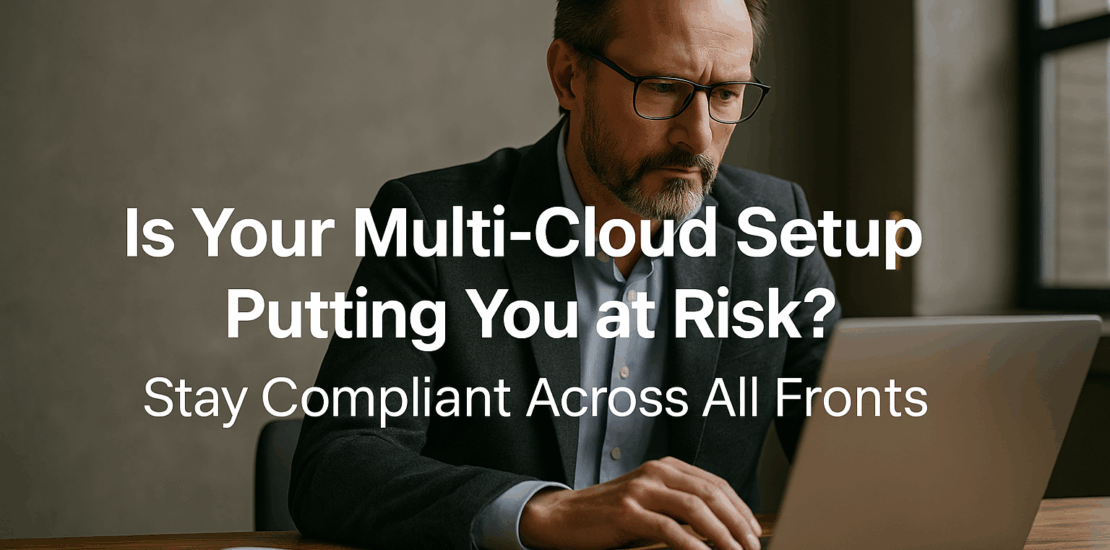Is Your Multi-Cloud Setup Putting You at Risk? Stay Compliant Across All Fronts
- July 21, 2025
- Posted by: Gradeon
- Category: Digital Services

As UK businesses increasingly adopt multi-cloud and hybrid cloud infrastructures, they open doors to scalability, flexibility, and cost-efficiency. But with these benefits comes a new challenge: staying compliant across multiple cloud environments.
From GDPR and ISO 27001 to industry-specific mandates like PCI DSS or NHS Data Security standards, maintaining compliance across fragmented infrastructure isn’t easy — and the stakes are high. Let’s explore how your multi-cloud setup could be putting you at risk, and what steps you can take to protect your business.
Understanding Multi-Cloud and Hybrid Cloud Setups
A multi-cloud setup uses services from two or more cloud providers — for example, storing workloads on both AWS and Azure. A hybrid cloud setup, on the other hand, combines on-premise infrastructure with public or private cloud services.
These models offer flexibility and cost optimisation, but they also multiply the surface area for compliance management.
Where Compliance Can Break Down
Lack of Unified Visibility
One of the most common risks is poor visibility. When data is scattered across providers, it’s hard to maintain a centralised view of access controls, data flows, and security postures — all of which are critical for compliance.
Inconsistent Security Standards
Each cloud provider has its own default settings and tools. Without consistent policies in place, your organisation might unknowingly create gaps in encryption, access management, or logging — resulting in potential violations.
Ambiguity in Shared Responsibility
Cloud vendors operate under a “shared responsibility model.” But many organisations assume the provider is handling compliance — when in reality, you’re responsible for most of it, especially around data handling, user access, and monitoring.
Audit Complexity
Preparing for audits in a multi-cloud environment often involves pulling logs and data from different platforms. If those logs are incomplete or misaligned, demonstrating compliance becomes difficult and stressful.
UK Regulations That Matter in Multi-Cloud Contexts
If your business is UK-based or processes data of UK citizens, you’re likely subject to:
- UK GDPR – requiring strict control and transparency over personal data
- ISO/IEC 27001 – the gold standard for information security management
- PCI DSS – mandatory for businesses handling card payments
- FCA, PRA, or NHS DSP Toolkit – depending on your industry
Failure to align your cloud infrastructure with these regulations can lead to serious financial and reputational consequences.
Key Steps to Maintain Compliance Across Cloud Environments
Establish a Unified Compliance Framework
Rather than treating each platform differently, implement a single set of compliance controls that apply across your cloud and on-prem environments. This approach allows you to monitor, measure, and adapt uniformly.
Use Automation Wisely
Automation tools can save you countless hours and reduce errors. Use them for:
- Continuous compliance monitoring
- Real-time misconfiguration alerts
- Generating audit-ready reports
Implement Centralised Access Control
Access to sensitive data should be tightly managed. Use Identity and Access Management (IAM) solutions that span all platforms, enforcing:
- Role-based access control (RBAC)
- Multi-factor authentication (MFA)
- Time-bound permissions for temporary access
Data Location and Sovereignty: A Real Compliance Risk
In a multi-cloud model, your data may be stored in different countries — sometimes without your knowledge. This can violate data sovereignty laws if personally identifiable information (PII) is transferred outside the UK or EU without proper safeguards.
Be sure to:
- Select cloud regions consciously
- Review each provider’s data residency policies
- Use contractual tools like Standard Contractual Clauses (SCCs)
Audit-Readiness: Simplified but Not Neglected
Many UK organisations struggle with cloud audits due to disconnected logs and inconsistent documentation. To simplify audits:
- Maintain a documented inventory of cloud assets
- Regularly review access logs and configuration baselines
- Perform quarterly internal audits before regulatory ones
Don’t wait for a compliance audit to reveal a misstep — proactive auditing is key.
Clarify Roles with Vendors
Always read the fine print. Many businesses assume their cloud providers handle everything, but that’s rarely the case. Ensure your contract:
- Clearly defines responsibilities for compliance
- Allows for data portability and deletion upon request
- Includes provisions for regular reporting and audit support
Building a Future-Ready, Compliant Cloud Strategy
Compliance isn’t a one-time checkbox — it’s a continuous effort. Businesses that succeed in multi-cloud and hybrid setups treat compliance as a strategic priority, not just a legal obligation.
Invest in people, policies, and platforms that support compliance from day one. This means training your teams, aligning with international standards, and continuously adapting as regulations evolve.
Conclusion: Stay Compliant, Stay Competitive
A multi-cloud strategy offers agility, but without strong compliance management, it can leave your organisation exposed. From fragmented data to unmonitored access, the risks are real — especially for UK businesses governed by strict data laws.
But with the right governance tools, consistent policies, and clarity over vendor roles, you can stay compliant across all fronts — and turn your cloud setup into a strategic advantage.
